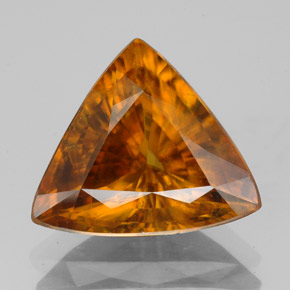The Gemstone Sphene

Sphene is the gemstone name of the mineral
Titanite. Sphene is known for its exceptional
dispersion, resulting in gemstones that show brilliant fire. The dispersion of Sphene exceeds even that of
Diamond. However, the relatively low hardness of Sphene inhibits its use as a mainstream gemstone.
Color
?
Green, Yellow, Orange, Brown
Chemical Formula
?
CaTiSiO
5
Additional Properties
|
Refractive Index
?
1.84 - 2.11 |
Double Refraction
?
.100 - .192 |
Transparency
?
Transparent |
SG
?
3.4 - 3.6 |
Luster
?
Adamantine |
| Cleavage ?
2,2 |
All About
Sphene comes in several colors, but the most prevalent color used in gemstones is yellowish-green to orange-brown. Sphene is also strongly
pleochroic, with different colors at different angles. Sphene gemstones often have
inclusions and
flaws, especially when in larger sizes. Clean Sphene gemstones are uncommon and are highly sought after.
Uses
?
Sphene is a minor gemstone and used mainly for collectors. Since Sphene gemstones have a low hardness and are easily scratched, they are limited to earrings and pendants when used in jewelry.
Treatments & Enhancements
?
Although the color of Sphene gemstones may be turned red or orange through
heat treatment, most Sphene gemstones remain untreated.
Sphene Sources
?
Gem Sphene sources include Austria, Brazil, Pakistan, Namibia, Madagascar, Russia, and Sri Lanka.
Similar Gemstones
?
Chrysoberyl, Beryl, Zircon, and Peridot all have a greater hardness.
Sphene in the Rough Photos
?